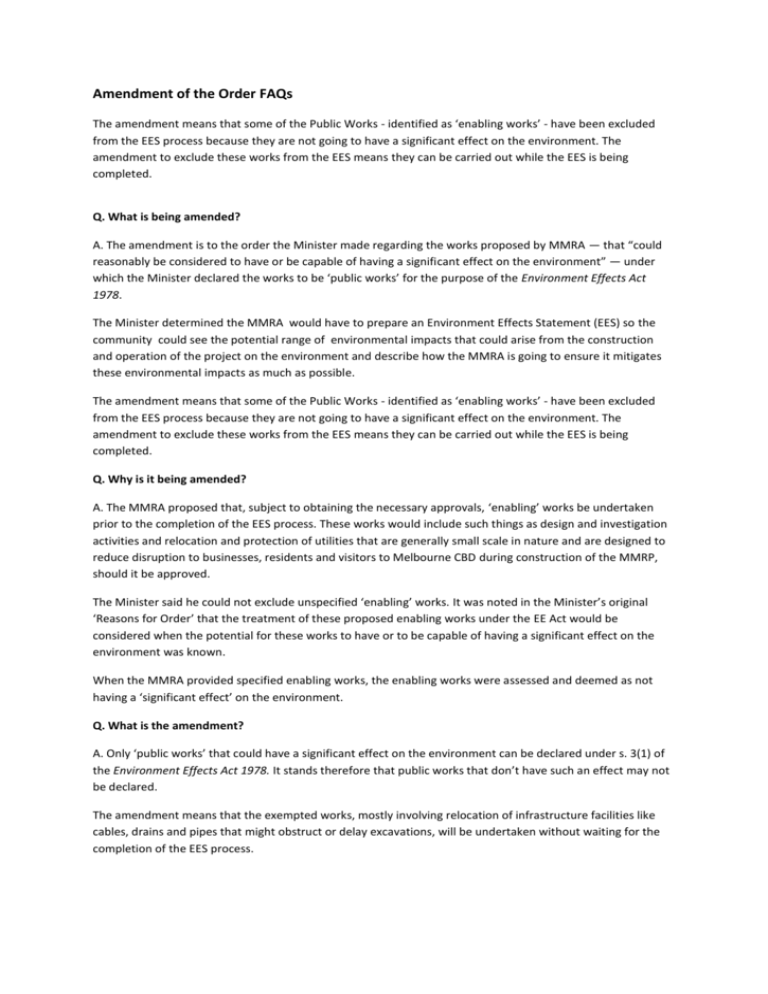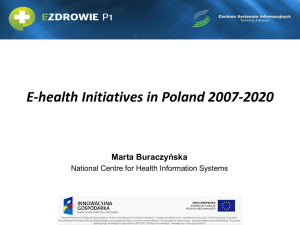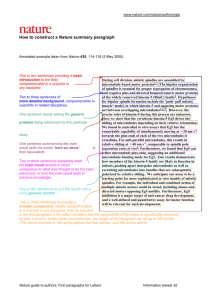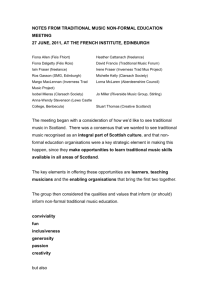Amendment of the Order FAQs [MS Word Document
advertisement

Amendment of the Order FAQs The amendment means that some of the Public Works - identified as ‘enabling works’ - have been excluded from the EES process because they are not going to have a significant effect on the environment. The amendment to exclude these works from the EES means they can be carried out while the EES is being completed. Q. What is being amended? A. The amendment is to the order the Minister made regarding the works proposed by MMRA — that “could reasonably be considered to have or be capable of having a significant effect on the environment” — under which the Minister declared the works to be ‘public works’ for the purpose of the Environment Effects Act 1978. The Minister determined the MMRA would have to prepare an Environment Effects Statement (EES) so the community could see the potential range of environmental impacts that could arise from the construction and operation of the project on the environment and describe how the MMRA is going to ensure it mitigates these environmental impacts as much as possible. The amendment means that some of the Public Works - identified as ‘enabling works’ - have been excluded from the EES process because they are not going to have a significant effect on the environment. The amendment to exclude these works from the EES means they can be carried out while the EES is being completed. Q. Why is it being amended? A. The MMRA proposed that, subject to obtaining the necessary approvals, ‘enabling’ works be undertaken prior to the completion of the EES process. These works would include such things as design and investigation activities and relocation and protection of utilities that are generally small scale in nature and are designed to reduce disruption to businesses, residents and visitors to Melbourne CBD during construction of the MMRP, should it be approved. The Minister said he could not exclude unspecified ‘enabling’ works. It was noted in the Minister’s original ‘Reasons for Order’ that the treatment of these proposed enabling works under the EE Act would be considered when the potential for these works to have or to be capable of having a significant effect on the environment was known. When the MMRA provided specified enabling works, the enabling works were assessed and deemed as not having a ‘significant effect’ on the environment. Q. What is the amendment? A. Only ‘public works’ that could have a significant effect on the environment can be declared under s. 3(1) of the Environment Effects Act 1978. It stands therefore that public works that don’t have such an effect may not be declared. The amendment means that the exempted works, mostly involving relocation of infrastructure facilities like cables, drains and pipes that might obstruct or delay excavations, will be undertaken without waiting for the completion of the EES process. In the event the project proceeds, following the conclusion of the EES process, having the enabling works completed could reduce delay to project delivery and reduce disruption to the community arising from project-related construction works . Q. So the ‘enabling works’ can just be carried out without any controls? A. No, the MMRA will need to fulfil environmental management commitments detailed in the published Enabling Works document as well as obtaining and complying with any necessary statutory approvals. Q. Why didn’t you get the order right the first time? A. It is not a matter of the original order being incorrect or wrong in any way. When the project outline was submitted, the enabling works for Melbourne Metro were still being determined and it was not possible at that point to provide definitive assurance that they would not have a significant effect on the environment. Q. Has the MMRA now provided the information that fully describes the impact of the enabling works on the environment? A. Yes, MMRA has provided detailed information in a document entitled Enabling Works Description which provides sufficient information to satisfy the Minister that the enabling works would not have a significant effect on the environment and therefore may be excluded from the EES process. Q. How was it decided (who decided) that the enabling works could be excluded from the EES process (would not have a significant effect on the environment)? A. The decision was made by the Minister for Planning, who is responsible for such decisions under the Environment Effects Act. Q. Where are the enabling works being carried out? A. The majority of the enabling works are to be undertaken in the Melbourne CBD and the inner city precincts of Parkville, Domain and South Yarra. Enabling works are also to be undertaken within the rail corridor south of South Yarra station. The enabling works are activities that are undertaken by utility service providers on a routine basis in the community and will be undertaken almost exclusively within existing road and rail reserves and public land. Private land will only be affected where service connections to private land need to be maintained. Q. Will residents be informed when enabling works are starting? A. The Melbourne Metro Rail Authority will ensure nearby residents and businesses will be fully informed about any enabling works in the area and any impacts that might result.








